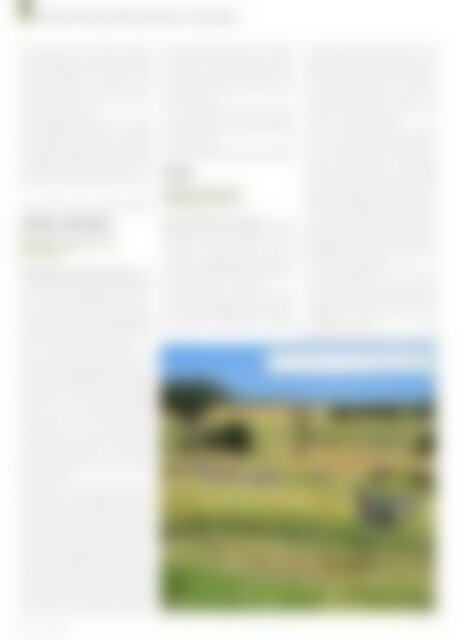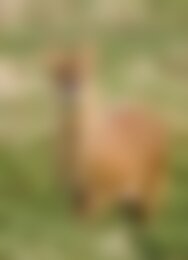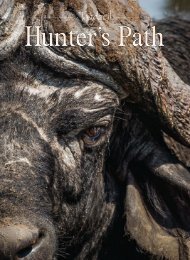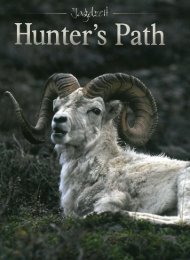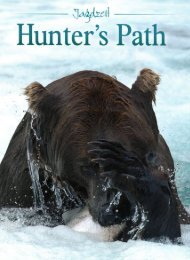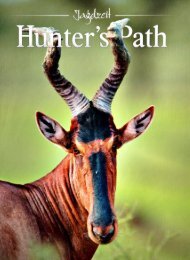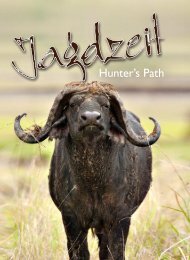Create successful ePaper yourself
Turn your PDF publications into a flip-book with our unique Google optimized e-Paper software.
HUNTING NEWS FROM AROUND THE WORLD<br />
hunters in order to earn revenue. As a result, the<br />
ungulate populations have increased considerably,<br />
and so have the numbers of snow leopards, wolves,<br />
and bears. Therefore the conservancies received<br />
the prestigious Markhor Prize from the CIC for<br />
their contribution to the conservation of biodiversity<br />
through sustainable use.<br />
While traveling through the Pamirs , CIC member<br />
Dr. Rolf D. Baldus handed over the first batch of<br />
spotting scopes and binoculars to the traditional<br />
hunters of Alichur village. The head of the German<br />
CIC delegation, Wilhelm von Trott zu Solz, thanks<br />
Optolyth-Sport Optics and all other donors. More<br />
information: http://www.wildlife-tajikistan.org/<br />
rdb<br />
GERMANY – SOUTH AFRICA<br />
World’s Largest Ivory<br />
Database<br />
SIGNATORIES TO CITES WILL SOON be able<br />
to freely access the world’s largest ivory database,<br />
which has been compiled using state-of-the-art forensic<br />
techniques developed by Germany. German<br />
Minister for the Environment Barbara Hendricks<br />
symbolically handed over the IvoryID database to<br />
CITES Secretary-General John E. Scanlon at CITES<br />
CoP17 in Johannesburg in September 2016.<br />
Scanlon said: “The use of modern forensics is a<br />
game-changer in the fight against the illegal wildlife<br />
trade. We are deeply grateful to Germany for<br />
developing a forensic technique that can determine<br />
the age and origin of ivory. Criminals illegally<br />
trading in ivory can no longer hide behind false<br />
claims of where and when they got their ivory.”<br />
The database, which can be accessed through a<br />
website, contains more than seven hundred reference<br />
samples from thirty African countries, using<br />
data obtained from elephant ivory with proven origin,<br />
and provided by countries of origin, museums,<br />
hunters, and others.<br />
Hendricks said: “I am pleased to add today this<br />
forensic element to the existing toolkit of CITES in<br />
the fight against ivory trafficking, and I would like to<br />
invite everyone involved in elephant conservation<br />
to use it effectively. I also have to express my sincere<br />
thanks towards the African nations, who made this<br />
project possible by providing qualified samples.”<br />
Germany has developed a forensic technique based<br />
on an analysis of isotopes that can determine the<br />
age and origin of ivory. This provides critical information<br />
about poaching hotspots and trade routes<br />
used by traffickers. The composition of specific isotopes<br />
used to determine origin differs significantly<br />
between geographical regions and ecosystems<br />
across Africa. This chemical fingerprint is imbedded<br />
in the ivory during the growth of the elephant.<br />
Proof of age can provide crucial evidence in court<br />
cases to determine if material has been recently<br />
poached or is antique.<br />
The IvoryID-website, which will be available at<br />
www.ivoryid.org also contains information about<br />
certified laboratories in the world that are able to<br />
apply these methods.<br />
ce<br />
KENYA<br />
Drastic Decline in<br />
Wildlife Numbers<br />
KENYA BANNED ALL HUNTING nearly forty<br />
years ago. The country is hailed for this by the<br />
worldwide animal welfare movement. However,<br />
Kenya is one of the best examples in Africa of a<br />
country whose wildlife population is declining. This<br />
is confirmed by recent research that was published<br />
by Joseph O. Ogute et al. in PLOS ONE.<br />
The team of authors for this research used systematic<br />
aerial monitoring data collected in rangelands<br />
that collectively cover 88% of Kenya’s land surface.<br />
The results show that wildlife numbers declined<br />
on average by 68% between 1977 and 2016. The<br />
magnitude of decline varied among species, but was<br />
most extreme (-72% - -88%), and now severely<br />
threatens the viability and future of warthog, lesser<br />
kudu, Thomson’s gazelle, eland, oryx, topi, hartebeest,<br />
impala, Grevy’s zebra and waterbuck. The<br />
declines were widespread and occurred in most of<br />
the twenty-one rangeland counties.<br />
Similar to wildlife, cattle numbers decreased<br />
(-25.2%), but numbers of sheep and goats (76.3%),<br />
camels (13.1%) and donkeys (6.7%) evidently increased<br />
in the same period. As a result, livestock<br />
biomass was 8.1 times greater than that of wildlife<br />
in 2011–2013 compared to 3.5 times in 1977–1980.<br />
The declines raise grave concerns about the future<br />
of wildlife, and the effectiveness of the wildlife conservation<br />
policies, strategies, and practices in Kenya.<br />
Causes of the declines include exponential human<br />
population growth, increasing livestock numbers,<br />
declining rainfall, and a striking rise in temperatures,<br />
but the fundamental cause seems to be policy, and<br />
institutional and market failures.<br />
The authors suggest policy, institutional, and<br />
management interventions that would be likely<br />
to succeed in reducing the declines and restoring<br />
rangeland health. Most notably they recommend<br />
strengthening and investing in community and private<br />
wildlife conservancies. <br />
rdb<br />
Kenyan wildlife numbers have plummeted since its hunting ban.<br />
Photo: iStockphoto.com<br />
6 | Hunter´s <strong>Path</strong> 4/2016


